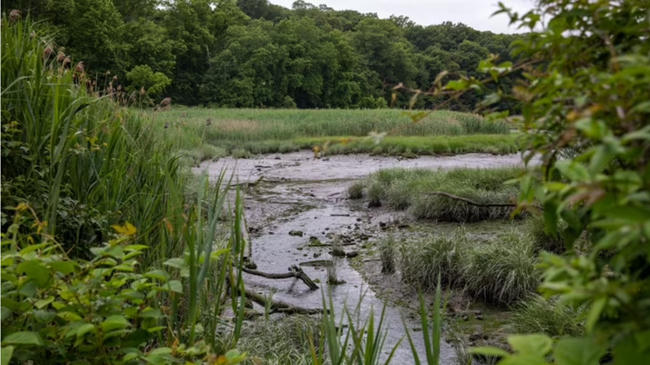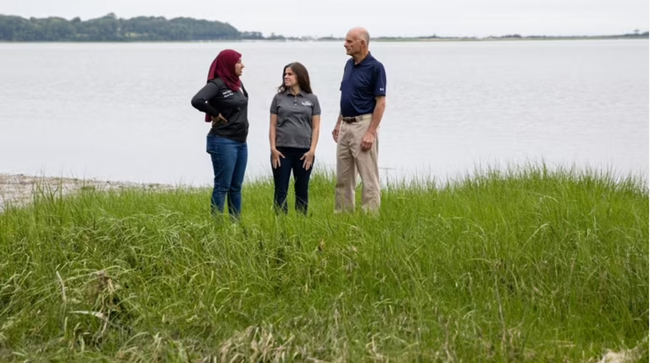Contacts:
Elizabeth Hornstein, NYSG Sustainable and Resilient Communities Extension Professional, Suffolk County, E: eeh78@cornell.edu, Phone: (631) 632-8730
Sarah Schaefer-Brown, NYSG Sustainable and Resilient Communities Extension Professional, Nassau County, E: scs292@cornell.edu, Phone: (516) 832-2591
— Filed by Brianne Ledda for Newsday
Stony Brook, NY, June 24, 2023 - Doug Dahlgard, village mayor of Head of the Harbor, is worried about the wetlands around Stony Brook Harbor.
He’s particularly concerned about the damage done by phragmites, an invasive plant that’s harmful to the marsh ecosystem. Marshes help recharge groundwater, improve water quality and reduce coastal storm damage. But beyond phragmites, Dahlgard and other local officials are concerned about the threat of rising sea levels that will impact the marshland surrounding the harbor.
The water body crosses municipal boundaries, which means solutions from any one local government can only be piecemeal; Dahlgard is limited to working within the borders of Head of the Harbor. But that's where environmental cooperatives like the Long Island Sound Study's Sustainable and Resilient Communities Work Group can help.

Tidal marsh with phragmites, an invasive plant that damages the marsh ecosystem, seen on Harbor Road near Cordwood Park in St. James on Friday. Credit: Morgan Campbell
Experts and numerous studies have predicted sea levels around Long Island could rise as much as six feet by the end of the century, washing away sections of barrier islands and making some shoreline neighborhoods uninhabitable, Newsday has previously reported. With that in mind, the work group has organized an initiative to create a conservation plan for the marsh surrounding Stony Brook Harbor. The group coordinates with representatives from multiple government agencies, including the towns of Brookhaven and Smithtown, and community groups like regional chapters of the National Audubon Society.

From left, Amani Khan, Brookhaven Town Council legislative aide, Elizabeth Hornstein, Suffolk County coordinator for Long Island Sound Study's Sustainable and Resilient Communities Work Group, and Doug Dahlgard, Head of the Harbor mayor at Cordwood Park in St. James on Friday. Credit: Morgan Campbell
New York and Connecticut Sea Grant, environmental education organizations, provide staffing for the five-person work group, which is funded by the federal Environmental Protection Agency. Elizabeth Hornstein, who is the Suffolk County coordinator for the work group, said the group's “goal is to help communities anticipate and overcome disturbances caused by a changing climate" such as sea level rise, extreme weather events and other impacts.
Hornstein, who is based at Stony Brook University, said the work group receives roughly $2 million in funding per year.
Launched in 2021, the work group has played a key role as a “ring leader” in the Stony Brook Harbor marsh project, said Phoebe Clark, senior manager of coastal resilience at Audubon Connecticut and New York.
“They’re able to identify who needs to be at this table, and what needs to be done, and they’re really able to help provide funding, especially for a lot of these smaller agencies,” she said.
The cooperative also provides funding to local governments, nonprofits and community groups to hire grant writers to secure funding from state and federal programs to cover projects such as living shorelines, green infrastructure, citizen science and oyster gardening programs.
Hornstein said the group so far has made 15 awards to municipalities and nonprofits ranging from $5,000 to $9,950.
Funding writers for grant applications is "huge for a small village," said Rebecca Kassay, a Port Jefferson Village trustee.
In Head of Harbor, Dahlgard said, "We don't have a commercial tax base. Everything falls on the residents, or we can get grants. And that's what we look for."
The village is still waiting to hear back on an application for a state Department of Transportation grant to replace a faulty culvert under Harbor Road with a bridge that would allow for more water flow from the harbor to an area, owned by the county, that is thick with phragmites.
The community group also hosts workshops and is developing an online resource hub for local municipalities.
Climate change "is a really scary thing for a lot of people. And the psychological response is just to shut off, to say, 'I don't want to hear it,'" Kassay said.
"But the sooner we acknowledge it, and start working together as a community ... that's when we're going to see success," Kassay added.
More Info: What To Know
• With Long Island facing a flood-filled future, a Long Island Sound Study work group is coordinating an initiative with lawmakers and community groups to create a conservation plan for the marshes surrounding Stony Brook Harbor.
• The cooperative, dubbed the Sustainable and Resilient Communities Work Group, receives roughly $2 million in funding from the U.S. Environmental Protection Agency per year with the goal to help communities formulate a plan.
• Group members are focused on providing resources such as funds to hire grant writers, and promoting collaboration between municipalities and community groups.
More Info: New York Sea Grant
New York Sea Grant (NYSG), a cooperative program of Cornell University
and the State University of New York (SUNY), is one of 34 university-based
programs under the National Oceanic and Atmospheric Administration’s
National Sea Grant College Program.
Since 1971, NYSG has represented a statewide network of integrated
research, education and extension services promoting coastal community
economic vitality, environmental sustainability and citizen awareness
and understanding about the State’s marine and Great Lakes resources.
Through NYSG’s efforts, the combined talents of university scientists
and extension specialists help develop and transfer science-based
information to many coastal user groups—businesses and industries,
federal, state and local government decision-makers and agency managers,
educators, the media and the interested public.
The program maintains Great Lakes offices at Cornell University, SUNY
Buffalo, SUNY Oswego and the Wayne County Cooperative Extension office
in Newark. In the State's marine waters, NYSG has offices at Stony Brook
University and with Cornell Cooperative Extension of Nassau County on Long Island, Brooklyn College and Cornell Cooperative
Extension in NYC and Kingston in the Hudson Valley.
For updates on Sea Grant activities: www.nyseagrant.org has RSS, Facebook, Twitter, Instagram, and YouTube links. NYSG offers a free e-list sign up via www.nyseagrant.org/nycoastlines for its flagship publication, NY Coastlines/Currents, which is published quarterly.